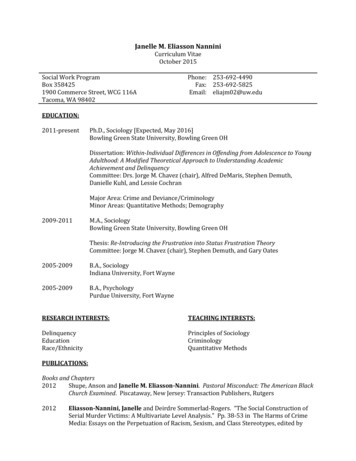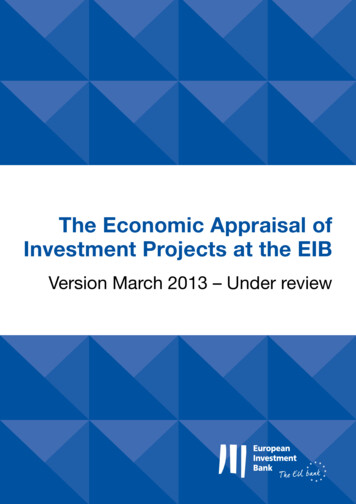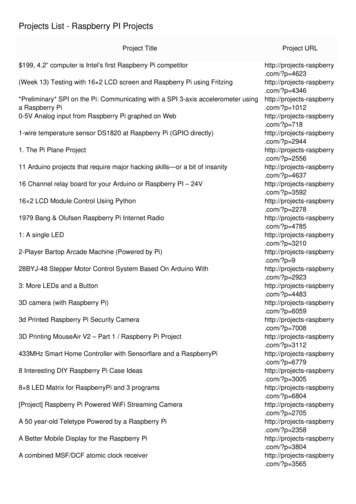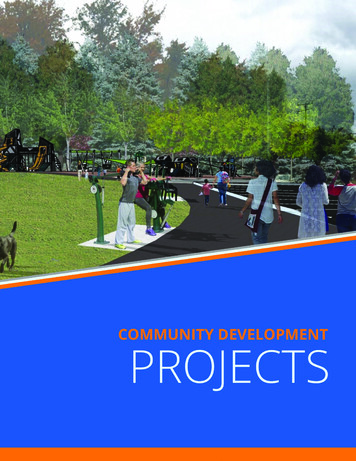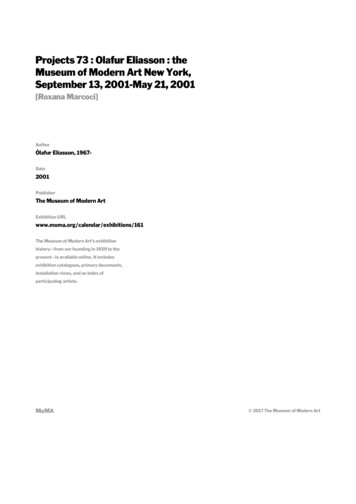
Transcription
Projects 73 : Olafur Eliasson : theMuseum of Modern Art New York,September 13, 2001-May 21, 2001[Roxana Marcoci]AuthorÓlafur Elíasson, 1967Date2001PublisherThe Museum of Modern ArtExhibition URLwww.moma.org/calendar/exhibitions/161The Museum of Modern Art's exhibitionhistory—from our founding in 1929 to thepresent—is available online. It includesexhibition catalogues, primary documents,installation views, and an index ofparticipating artists.MoMA 2017 The Museum of Modern Art
OOtSf02iIV!5sefflmSeolem'er !ilf§ gofHiBdelWVrt2
123phenomenologicalinvestigationsAsked to describe his work, Olafur Eliassonwould reply pointblank: "My work is you—the spectator." Capsizing the classicalsituation in which the viewer contemplates an art object, Eliassonenlists the viewer as a participant in the aesthetic makeup of hispractice. The installation Seeing yourself sensing (2001), conceivedfor The Museum of Modern Art's Garden Hall windows, provokesa body-conscious response to space and architecture that probesthe potential of human perceptual processes. A total of fiftysheets of striped pellucid and mirrored glass extend over theGarden Hall facade on the first two floors, producing an experiential field in constant flux that unsettles the habitual dichotomyof interior/exterior and perceiver/perceived. Eliasson'spremise isour phenomenological engagement with the artwork. Activatedby the presence of one or more viewers, this installation changeswith our own shifts in space and investigations in real time. Bychanging our physical position we implicitly change our viewpoint,thus perceiving the work diversely and also disrupting andreordering its previous structure. Differently put, we continuouslyaffect our surroundings, engendering new cognitive situations.as well as the notion of a universal viewing subject. To see oneself inthe third person is to see actively, to see critically, to see through theframe. There are various frames through which one looks at an artwork,including the institutional construction of space and the discursivepractices surrounding it. Surroundings are not only natural—they arealso social, cultural, and ideological.Eliasson'sperceptual inquiries can be traced back to his student years atthe Royal Academy of Fine Arts in Copenhagen. Exposed to theoreticalphenomenology—the writings of Edmund Husserl, Martin Heidegger,and Maurice Merleau-Ponty— he began experimenting with visualphenomena, testing the real and its conventions. Light, space, and timehave often functioned as prime building blocks. For instance, in Yoursun machine, installed in 1997 in an art gallery in Santa Monica, Eliassoncut a circular hole in the roof, letting the light flood in and rotate acrossthe walls and floor during the course of the day, punctuating duration.The empty gallery space read as a monitoring chamber engineered tochart the movement of the solar orb, but its effect actually derived fromthe way we tend to observe other forms in the universe from our ownposition on earth. Although the sun may seem to be moving out there,Here, our eye alternates between looking outside into The Abbyit is in fact our own astronomical spin around it that makes it appearAldrich Rockefeller Sculpture Garden— now in a state of motility,under construction — and looking back inside at the deploymentthe way that it does. The piece prompted us to rethink perception interms of the subject's mobility in space, but also to take into account theof a space fragmented and multiplied into many mirroringfull sensorial dimension of vision and its potential for criticality. Your sunmachine called to mind projects by California "light and space" artistsimages. We engage in the play-tactics of reflections and becomeaware of ourselves, our performing bodies, our gazes, and, notleast, the gazes of others. Watching ourselves look, we uncoverthe ways we see and, in turn, observe ourselves being observed.Robert Irwin, Maria Nordman, Douglas Wheeler, and, especially, JamesTurrell, whose skyspacesfrom the 1970s similarly explore the light-timeratio, the motion of the earth in space, and the ways in which humanPerceptions interface and morph in endless volleys, a processEliassondefines as "seeing yourself sensing." Marking a radicalbreak with the Cartesian scopic regime, which prevailed inever, is that Eliasson'sobjective, here as elsewhere in his practice, is notjust to prospect the zone of the phenomenal, but also to investigateWestern culture from the Renaissanceinto the first decades ofthe twentieth century, Eliassonpresents perception not as unibroader philosophical questions about the link between vision and truth,sensation and interpretation.versal and autonomous, but as it is lived in the world. Perceptionmanifests itself as embodied in a specific context or situation,Made of light, or cognate elements such as water, fog, ice, mist, and fire,grounded in circumstance. Conversely,just as perception doesnot exist in and of itself, our surroundings cease to be presentwithout us.Eliasson'sinstallations conjure up physical phenomena. They appear tobe "natural," yet oddly are not— invariably, they are artificially induced.For instance, 360-degree expectation (2001) consisted of a circular room,Then, again, all this may be considered in reverse. Eliasson likesthirty-three feet in diameter. The only element in the room besides theviewer was a lens salvaged from a lighthouse, in which a halogen bulbto think about the paradox of the deflected gaze. What does itmean for the viewer to see herself from the outside— let's say,from the perspective of another person? What does it mean toobserve oneself from the vantage point of the space one occupies? Or from the outlook of the city? Or of other surroundings?Eliassonrefers to the story of "a space with a chair in it." It goeslike this: "When there are no people in the space, there is alsono chair; and if there are two people in the space with one chair,then there are two chairs. Then, if there is one person and nochair the interesting question arises: is the person in the space?"beings engage the world with their visual systems. The difference, howhad been set. The gyratory lens projected a circle of ethereal light thatmoved up and down onto the surrounding walls like a horizon line. Amakeshift mechanical gear created an uncannily cosmic sensation. At thelevel of affect, the authentic and the artificial became interchangeable,though nothing disguised the technical intervention. The reason a simulated phenomenon, such as the ersatz horizon line, can look real, isbecause we tend to naturalize the real world to the point where itbegins to resemble its own representation. Stirred up by images of hisnative Scandinavia, Eliasson'sindoor rainbows, double sunsets, fabricatedgeysers, reversed waterfalls, and ice fields for tropical countries emphasize not the wonders of nature, but, on the contrary, the ways in whichSeeing yourself sensing addressesthe antinomies of perception:the idiosyncratic rapport between viewer and object (for instance,the situation in which two people looking at any one objectcultural sites mediate our perception of pure processes.By making visiblethe mechanics of his works and laying bare the artifice of the illusion,signifies that there are two objects, not one), and the objectivescope of subjective seeing (for instance, the situation in whichEliassonpoints to the elliptical relationship between reality, perception,and the representation of the real. Yet even as his work exposes thethe spectator perceives herself being looked back at by an object).technologies that structure natural processes,it still fosters an indelibleemotion— "perhaps even with connotations of the sublime," MadeleineGrynsztejn notes— an emotion that is embedded in human agency.This Brechtian distancing exerciseexplains why perception involvesa state of consciousnessthat challenges the innocence of space
What, then, is ultimately at stake in Eliasson'swork? It is a quest neitherfor nature nor for culture, but a movement toward the renewal of subjective perceptual experience. Perhapsthis explains why the titles of hisinstallations often introduce the possessivepronoun "your" to articulatesomething that belongs to the beholder— her point of view. If the artistdevises the environments, it is you, the viewer, who activates them; andit is your visual experience that in the end completes the work. Eliasson'sparadigms for perceptual criticality are "seeing yourself seeing" and"seeing yourself sensing." What begins as perception returns to affectthe structures of society. Accordingly, perception functions as an agentof consciousnessthat evolves from a concern with things seen to thatof seeing oneself. The prospect of ocular agency has many implications,most notably, an engagement with unpredictability. Becauseeverythingin our society is organized to avoid surprises, experiencing "the value of4nsomething that's unpredictable," Eliasson reasons, "can also be seen asa critique of society."Informed by the discursive practices and social analysesof Michael Asher,Gordon Matta-Clark, and Dan Graham, Eliassonconceives situationsthat disrupt the normative exhibition conventions of galleries andmuseums. The institutional tendency is to disassociate the space of artienfrom the outer world, and to display art "objectively," with an eye for"truth." Set against this grain, Eliasson'sexperiential spaces seek toenhance human sensory faculties and to restore a sense of subjectivecriticality to perception. A work by Eliassonis not an object per se, butrather a process that is constantly redefined by the viewer. In Your nowis my surroundings (2000), Eliassonliterally turned the space of theTanya Bonakdar Gallery, New York, inside out by removing the glasspanels from the skylight overhead, yet preserving the latticed metalframe, which reiterated itself in mirrors strategically placed on walls ateye level. The installation was activated only when viewers entered thei,a,space. Looking around, participants saw a fragmented, disorientingmirror world that seemed to exist both inside the gallery and outside,in the city. They saw themselves from different angles, bodiless, theirunanchored gazes endlessly self-replicated. They felt a breeze and heardthe sounds of the city. Reality— as in the social world —was "here andnow," present in all its multiplicity, epiphany, contingency, and intensei,immediacy. Aesthetic experience, Eliasson'swork attests, is a processof exchange between the viewing subject, the art construct, and thecontext, rather than any fixed endpoint of such a process.Roxana Marcoci, Department of Painting and Sculpture,and Claudia Schmuckli, Department of the Chief Curator at Largenotes1 Conversation with the artist, August 2000.2 Olafur Eliassonand JessicaMorgan, Your only real thing is time(Boston: Institute of Contemporary Art, 2001): 22.3 Madeleine Grynsztejn, Carnegie International 1999/2000(Pittsburgh: Carnegie Museum of Art, 1999): 102.4 Leslie Camhi, "And the Artist Recreated Nature(or an Illusion of It)," New York Times, January 21, 2001, sec. 2, 35.Right: Your natural denudation inverted. 1999. Installation: Wood, rubber, water, steam, andexisting architecture (Sculpture Courtyard, Carnegie Museum of Art), 8 x 48 x 83'. CourtesyTanya Bonakdar Gallery, New York, and neugerriemschneider, Berlin. Photo: Richard A. Stoner
seeingyourselfsensingHi there landscape! I say—and look. In front of me, at first, a flatdark area with some water or marshy spots, until the jumpwidestream delimits the small brown elevations with knee-high birches.Behind them, more hills and more colors. Different small trees butmostly moss. Further away, different light, higher slopes, and moreyellow colors. Shadows from even higher mountains shading thevalleys. And finally the mountains, furthest away, bright with thecolors and lit by the sun, not really high but distinctly organizedin the background panorama, fitting well under the white sky. HiOlafur! I answer for the landscape.By now I can tell approximately how far it is to the second row ofhills or to the mountains further away. I can estimate how muchtime and what effort it would take to go from here to there. Ican tell if the water in the stream runs faster than I can walk, andthat by the time I get to the mountain the sun will be low andthat it would have been better to walk up the western side ofthe mountain to enjoy the evening heat. If I want to take photoswhile walking up the mountain I should go up the eastern shadedside, so that the landscape is lit from behind. I believe that at thefoot of the mountains, not visible from here, there is a glacierriver, which I would have to wade through. Even though I don'tfancy the cold water, I have got some sense of where and wherenot to go. Where there is a stone and where there is a hole underthe water. And if the river is too large to wade through, I imaginethat further away, at the outspring, there is a small glacier tongue,and envisioning it (although sometimes I'm wrong) I can see whichis the safer path up and down the ice, with the smaller crevasses,and so on.I am not trying to advertise the little experience I have had overthe years. In the hiking and trekking world I am an absolutenovice and will probably stay one for ever. But what I want tosay here is that after visiting the same type of landscape severaltimes, I have achieved a level of orientation. I can determine the
latapproximate height of the hills and the slope angle, estimate the timeit takes to get there, and try to use the weather to my benefit. As withlenes.the cityscape, I can relate to the landscape— not as an image, but as abutlorespace. So what is it that I have come to know? Is it nature? Nature assuch has no essence— no truthful secrets to reveal. I have not got closerheheto anything essential outside of myself and, finally, isn't nature a culturalstate anyway? Talk to me about cultivating nature into landscapes. . . .dHiWhat I have come to know better is my own relation to so-called nature(i.e., my capacity to orient myself in this particular space has been exercised)— is my ability to see and sense and move through the landscapessurrounding me. So looking at nature, I don't find anything out there . . .I find my own relation to the spaces, or aspects of my relation to it. Wesee nature with our cultivated eyes. Again, there is no true nature, thereis only your and my construct of such.Just by looking at nature, we cultivate it into an image. You could callthat image a landscape. The museum presents itself to us as a placefor art. For a while now, it has been meaningless to speak of objective,autonomous conditions. This is not only vis-a-vis art objects, but alsoexhibitions and the museum's position in society in general. As in manyother fields, the acknowledgment of this has meant that the wholenotion of orientation and observation has changed. Even in physics thesubatomic particles can no longer be subjected to a causal descriptionin time and space. Exercisingthe integration of the spectator, or rather,the spectating itself, as part of the museum's undertaking, has shiftedthe weight from the thing experienced to looking at the experienceitself. We stage the artifacts, but more importantly, we stage the waythe artifacts are perceived. We cultivate nature into landscapes. So toelude the museum's insistence that there is a nature (so long as youlook hard enough for it), it is crucial not only to acknowledge that theexperience itself is part of the process, but more importantly, thatexperience is presented undisguised to the spectator. Otherwise, ourmost generous ability to see ourselves seeing, to evaluate and criticizeourselves and our relation to space, has failed, and thus so has themuseum's socializing potential.
The Museum of Modern Art, one of the most highly esteemed museumsin the world today, is at the moment partly a construction site. I wouldlike to think of the awareness of this architectural intervention, includingthe construction site, as part of my project, and use this moment ofmegamuseomanic instability as an occasion for visitors to take on theeyes of the museum and look back— at themselves. To reverse the perspective: the museum as the subject, and the spectator, the object. Tosee that, like a landscape, the museum is also a construct—that in spiteof its comprehensive and far-reaching role as a truthful myth, it canindeed have social potential. Seeing yourself sensing.Olafur EliassonThe Abby Aldrich Rockefeller Sculpture Garden (under construction). June 2001Photo: Roxana MarcocibiographyOlafur EliassonBorn 1967 in Copenhagen, Denmark. Livesand works in BerlinEducation 1989-95 Royal Academy of Fine Arts, Copenhagenselected solo exhibitions2001Your only real thing is timeThe Institute of Contemporary Art, BostonSurroundings surrounded2000Zentrum fur Kunst und Medientechnologie, Karlsruhe, GermanyYour now is my surroundingsTanya Bonakdar Gallery, New YorkYour intuitive surroundings versusyour surrounded intuitionThe Art Institute of ChicagoacknowledgmentsWe would liketo acknowledgeour profoundgratitudeto the artist,OlafurEliasson,and our appreciationof the invaluableassistanceof Pat Kalt of StudioOlafurEliasson,and TanyaBonakdarof TanyaBonakdarGallery,New York.We alsothankLaurenceKardish,whosesteadfastsupport hasmadethis r,NorieMorimoto,and CarlosYepes,for their workon the exhibitionand brochure.The projectsseriesis sponsoredby PeterNorton.Brochure 2001 The Museumof ModernArt, New YorkTop left: 360-degree expectation. 2001. Halogen bulb and beacon lens, circular room, 33' diam.Installation view. The Institute of Contemporary Art, Boston. Courtesy Tanya BonakdarGallery, New York, and neugerriemschneider, BerlinBottom left: The double sunset. 1999. Twenty 2000-watt xenon lamps, yellow corrugatedmetal, and metal scaffolding, 184 x 125' diam. Installation view. Central Museum Utrecht, TheNetherlands. Courtesy Tanya Bonakdar Gallery, New York, and neugerriemschneider, BerlinBottom right: Your now is my surroundings. 2000. Mirror, skylight, concrete tiles, drain pipe,drywall, and insulation, 25' 8" x 6' 10 1/2" x 13'. Courtesy Tanya Bonakdar Gallery, New York,and neugerriemschneider, Berlin
frame. There are various frames through which one looks at an artwork, including the institutional construction of space and the discursive . social, cultural, and ideological. Eliasson's perceptual inquiries can be traced back to his student years at the Royal Academy of Fine Arts in Copenhagen. Exposed to theoretical phenomenology—the writings of Edmund Husserl, Martin Heidegger, and .


